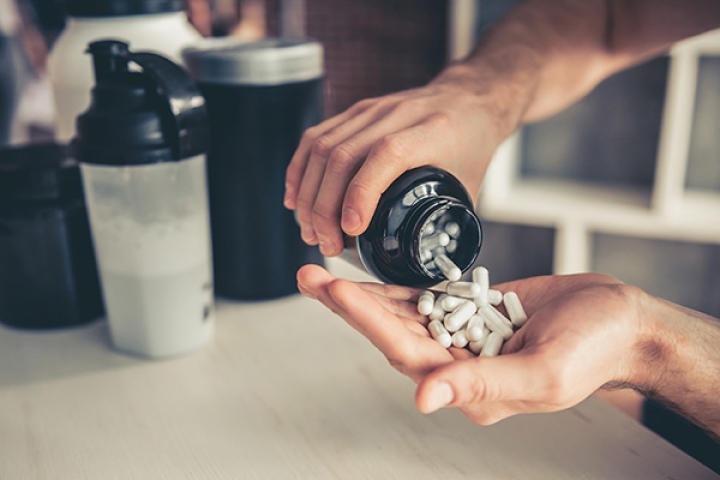Niacin Benefits and Types
You might know niacin as nicotinic acid or vitamin B3. Whichever label you choose, niacin is an essential human nutrient—along with 15 minerals, 12 other vitamins, nine amino acids, and a couple of fatty acids—that your body cannot produce on its own but is required for normal physiological function.
Thus, along with those other essential nutrients, you need to get your daily dose of niacin from the foods you eat or from a combination of foods and dietary supplements. Niacin is also a water-soluble vitamin, which means your body can’t store it, making it even more important to monitor your intake to maintain a healthy level. Insufficient amounts of niacin may cause health concerns such as headaches or fatigue.
Like all other B complex vitamins, niacin plays a role in converting food (carbohydrates) into energy (glucose) by assisting various enzymatic activities. Niacin is a significant component of both NAD and NADP, two related coenzymes involved in cellular metabolism (your body’s most basic form of energy). Niacin also contributes to DNA synthesis and repair and can act as an antioxidant.
Recommended Dietary Allowance (RDA) for Niacin:
Children
- 1–3 years: 6 mg/day
- 4–8 years: 8 mg/day
- 9–13 years: 12 mg/day
Men and Women
- Men (14 years and older): 16 mg/day
- Women (14 years and older): 14 mg/day
- Pregnant women: 18 mg/day
- Breastfeeding women: 17 mg/day
Why Do People Take Niacin Supplements?
Ample evidence compiled from several scientific studies indicates that niacin can significantly promote healthy cholesterol levels. This is the primary reason why people add a niacin supplement to their daily routine.
Research demonstrates that niacin can help maintain healthy levels of HDL cholesterol within the normal range while also supporting proper triglyceride levels. Although the effect on LDL cholesterol is less pronounced, the combined benefits are substantial enough that healthcare providers often recommend niacin supplements in conjunction with a healthy diet and exercise program to maintain overall cholesterol levels within the normal range.
Since cholesterol is a major factor in cardiovascular health, it should be no surprise that niacin also supports heart health. According to WebMD, there’s strong evidence showing niacin can support healthy arteries. While studies have shown potential benefits in other areas of health, including joint, sleep, and cognitive health, more research is needed. Thus, cholesterol and heart health remain the primary reasons why people take niacin.
Different Forms of Niacin (Including “Flush Free” Niacin)
Niacin is available in three forms:
- Inositol hexaniacinate, or IHN
- Niacinamide
- Nicotinic acid, also referred to as regular niacin
Nicotinic acid is the form most often associated with cardiovascular health benefits, as it promotes healthy levels of HDL and LDL cholesterol already within the normal ranges, as well as triglycerides. Inositol hexaniacinate (IHN) is the flush-free niacin supplement, and opinions vary widely as to its effectiveness in supporting the cardiovascular system and altering lipoprotein levels. Nevertheless, it remains a popular choice for those who wish to avoid the flush.
So what’s with the flushing? High doses of regular niacin can cause various side effects, the most common of which is known as “niacin flush.” People experience this effect in different ways—a general warmth, itching, redness, a tingling feeling under your skin, or red or flushed skin without any associated sensation.
Food Sources of Niacin
For those who’d prefer not to add another vitamin to their daily regimen, good news: Mother Nature offers a wide range of options for getting your daily intake of niacin. Even better? You’ve got both meat and vegetarian sources from which to choose.
Fortified breakfast cereals, oddly enough, are among the richest sources of niacin you’ll find at the supermarket. Wheat, rice, barley, or corn whole grain flours and pasta are also high in niacin. For the purists, though, here’s a list of whole foods that offer some of the highest niacin concentrations per 100 grams:
Meat:
- Cooked skipjack tuna: 18.8 mg
- Cooked light meat turkey: 11.8 mg
- Cooked lean ground pork: 11.1 mg
- Cooked venison: 10.8 mg
- Cooked lean veal: 8.0 mg
Non-meat:
- Sesame seed flour: 12.5 mg
- Ground ginger: 9.6 mg
- Dried tarragon: 9.0 mg
- Grilled portabella mushrooms: 6.2 mg
- Roasted sunflower seeds: 4.1 mg
- Dehydrated apricots: 3.6 mg
- Baked potato: 3.1 mg
How do you get vitamin B3 (niacin) in your diet?
Featured Products
| Niacin | Flush Free Niacin | Sustained Release Niacin |





Leave a comment